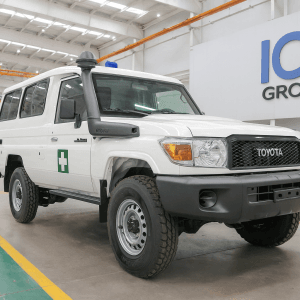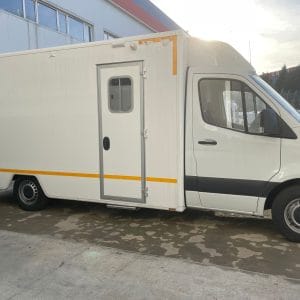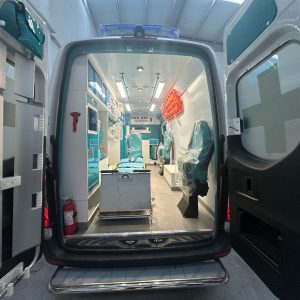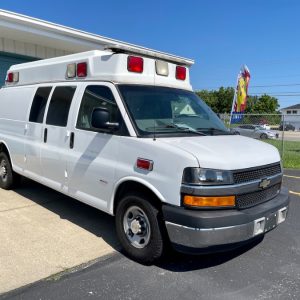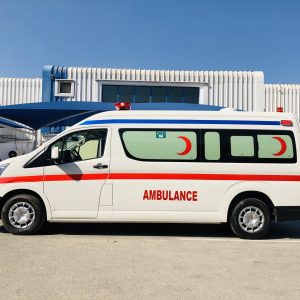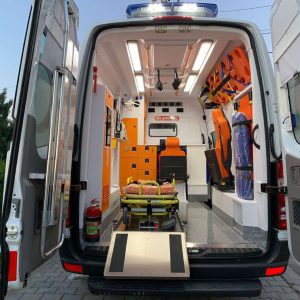Introduction
Toyota Hiace High Roof Ambulance ; The Toyota Hiace is one of the most popular van models for ambulance conversions around the world. First introduced in 1967, the Hiace has been in continuous production ever since and is currently in its sixth generation.
With its boxy shape, rear-wheel-drive configuration, multiple size options, and proven reliability, the Hiace makes an ideal base for ambulance conversions. Its high roof variants, in particular, allow plenty of headroom to stand up fully inside the back even after adding in all the necessary medical equipment and storage.
The Hiace high roof has been used as ambulances for decades across Asia, Australia, Europe, Africa, and the Americas. It offers a perfect balance of interior space, maneuverability, durability, and affordability.
While the latest Hiace generations have become more car-like and comfortable, they retain the ruggedness and versatility that have made the name synonymous with ambulances worldwide. With over 18 million Hiaces sold to date globally, it remains one of the most trusted commercial vehicles on the road.
Hiace High Roof Design
The Toyota Hiace High Roof ambulance has ample interior space and headroom to accommodate emergency medical personnel and maneuvering patients on stretchers. With a high roof height of 1,985 mm (6.5 feet), there is sufficient clearance for most EMTs and paramedics to stand fully upright when working inside the ambulance.
The interior height allows for upper ambulance cabinets and storage to be installed above the heads of emergency staff without impeding movement. This creates a functional layout where frequently used medical supplies can be stored up high, while leaving lower cabinet space for larger equipment.
The side entryway of the Hiace High Roof has a wide opening and low step-in height of just 440 mm (17 inches) from the ground. This makes it easy for EMTs to quickly load in patients on stretchers without excessive lifting. The low entry point also reduces the chance of back injuries for emergency medical staff from repetitive stooping and heavy lifting during stressful callouts.
Overall, the generous headroom and accessibility of the Toyota Hiace High Roof ambulance provides an optimal workspace for paramedics and optimizes patient loading and unloading. The interior dimensions allow efficient storage while enabling emergency crews to stand and move freely when providing urgent medical care.
Interior Layout
The Hiace High Roof Ambulance features a spacious interior layout optimized for medical transport. It utilizes a bench seat configuration to accommodate patients, EMTs, and medical equipment.
The bench seating provides room for a stretcher, medical attendant seats, and additional fold-down seats when needed. The long wheelbase maximizes interior space for multiple patients or attendants.
A full-height partition wall separates the driver cabin from the rear patient compartment. This allows the driver to focus on the road while EMTs have privacy to administer care behind the partition.
Storage compartments, cabinets, and hooks keep medical equipment organized yet easily accessible. Oxygen tanks, stretchers, and other gear can be stored and secured while on the move. The open floor plan leaves room for attendants to maneuver around patients during transport.
Overall, the well-planned interior layout allows the Hiace High Roof Ambulance to effectively serve as a mobile treatment center. It provides ample room for patients, EMTs, and the vital medical equipment needed to deliver critical care.
Power and Performance
The Hiace High Roof Ambulance comes equipped with Toyota’s reliable 2.7L four-cylinder petrol engine or a 2.8L turbo diesel engine. Both engine options provide ample power for an ambulance application, though the turbodiesel offers better torque for quick acceleration when needed.
The petrol engine produces 164 horsepower and 181 lb-ft of torque, which is fed through a 5-speed manual or 4-speed automatic transmission. This allows the Hiace to reach 100km/h from a standstill in about 12 seconds. The turbodiesel generates 174 horsepower and 332 lb-ft of torque, enabling faster acceleration to 100km/h in approximately 10 seconds.
While not a sports car by any measure, the torque-rich diesel engine provides strong performance for overtaking and merging onto highways, which is important for emergency response vehicles. The automatic transmission also has a manual shift mode that gives the driver more control over gear changes when powered by the turbodiesel. Overall, both the petrol and diesel Hiace High Roof models offer a good blend of power and efficiency for ambulance duties.
Ride and Handling
The Toyota Hiace High Roof Ambulance is designed for stability and easy maneuverability to ensure a smooth and comfortable ride for patients. It features an independent front suspension with coil springs and stabilizer bar as well as leaf springs with stabilizer bar at the rear. This provides good bump absorption over uneven road surfaces.
With a ground clearance of 175mm, the Hiace can easily handle bumpy rural roads or low city curbs. The higher ground clearance prevents the underbody from scraping over obstacles. The ambulance has a tight turning circle of 5.2m, allowing for easy U-turns and maneuvering in tight spaces which is useful when accessing cramped city streets or apartment complexes.
Overall, the Hiace ambulance provides a stable, smooth and comfortable ride quality even at higher speeds. The capable suspension system and higher ground clearance gives patients a less jarring experience while being transported for medical care. The tight turning circle also enables convenient and nimble handling for drivers accessing difficult locations.
Toyota Hiace High Roof Ambulance Safety Features
The Toyota Hiace Ambulance comes equipped with advanced safety features to protect patients and medical personnel. The vehicle has a range of airbags, including front airbags for the driver and passenger, side airbags, and curtain airbags that run the length of the cabin. These airbags help cushion occupants and prevent injuries in the event of an accident.
For improved braking performance, the Hiace Ambulance is fitted with anti-lock braking system (ABS). The ABS prevents the wheels from locking up under hard braking, allowing the driver to maintain steering control. This is crucial for maintaining vehicle stability and avoiding skids, especially when transporting patients.
Vehicle stability control is another important safety system in the Hiace. It uses a network of sensors to detect loss of traction or slide, and automatically applies brakes to individual wheels and manages engine power to keep the vehicle stable. This electronic stability control gives the driver more confidence and control when maneuvering the ambulance at higher speeds or in slippery conditions.
With airbags, ABS, and stability control, the Toyota Hiace Ambulance provides medical teams with the active and passive safety technologies required to transport patients securely. These systems work together to avoid accidents, and protect occupants if a collision occurs.
Medical Equipment
The Toyota Hiace ambulance comes equipped with a range of standard medical equipment to provide effective emergency care while transporting patients.
Standard Inclusions
The standard Hiace ambulance includes essential medical devices such as:
- Stretcher – A durable foldable stretcher with straps is provided to securely transport patients.
- Defibrillator – A lifesaving defibrillator is included to resuscitate patients in cardiac arrest.
- Suction Unit – A suction pump removes fluid and clears airways during transport.
- Oxygen Delivery – Oxygen cylinders, a regulator, and masks provide supplemental oxygen.
- BP Monitor – A digital blood pressure monitor allows medics to track vitals.
- Pulse Oximeter – This clips to a finger to measure oxygen saturation levels.
- Penlight – For checking pupil response and eye examinations.
Optional Additions
There are also many optional medical add-ons available such as:
- Ventilator – A transport ventilator can be installed for patients needing assisted breathing.
- Infusion Pumps – Allows accurate delivery of IV fluids and medication.
- Cardiac Monitor – Advanced ECG and arrhythmia analysis.
- Capnography – Measures exhaled CO2 levels.
- Nebuliser – Delivers asthma medications via mist inhaled into lungs.
This wide range of standard and optional equipment allows the Hiace ambulance to be customised for specific emergency response needs. The medical gear transforms the van into a reliable mobile treatment centre.
Fuel Efficiency
The Toyota Hiace High Roof Ambulance is powered by a 2.7L petrol engine or a 3.0L turbo diesel engine. The petrol engine is paired with a 5-speed manual or 4-speed automatic transmission, while the diesel comes with a 6-speed manual.
Fuel tank size on the Hiace Ambulance is 70 liters, which gives it excellent range to handle long trips and extended emergency response duties. With the manual transmission, the Hiace returns impressive fuel economy of 8.7L/100km on the combined cycle for the petrol engine and 8.2L/100km for the turbo diesel. The automatic petrol version is rated at 9.5L/100km.
With its large fuel tank and frugal engines, the Hiace can easily cover over 800km between refueling stops. This reduces downtime spent refueling and allows emergency crews to focus on the critical job at hand. The Hiace High Roof Ambulance delivers the range and endurance required for intensive emergency medical services.
Toyota Hiace High Roof Ambulance Maintenance
The Toyota Hiace High Roof ambulance is designed for durability and low maintenance costs. Toyota provides comprehensive service and warranty coverage to keep your ambulance on the road.
Toyota Hiace High Roof Ambulance Service Intervals
Toyota recommends servicing the Hiace every 6 months or 10,000km, whichever comes first. The scheduled service includes an oil and filter change, inspecting brakes, drivetrain, chassis, steering, and more. This regular maintenance helps maximize the lifespan of components and prevent major repairs down the road.
Warranty
Every new Hiace ambulance comes with a 3 year/100,000km warranty which covers any manufacturing defects. The warranty is fully transferable if the vehicle changes ownership. Extended warranty options are also available to provide additional coverage beyond the factory warranty period.
Overall, the Hiace ambulance is built to be serviced infrequently and operate reliably for many years. The service intervals and warranty provide peace of mind that your investment will be protected from unexpected repair bills. Regular maintenance is key to keeping your Hiace in optimal condition as a dependable emergency response vehicle.
Conclusion
The Toyota Hiace high roof is an excellent choice for an ambulance conversion. Its spacious interior with high ceilings provides ample room for transporting patients on stretchers and allowing EMTs to move around easily to provide care. The vehicle’s powerful yet fuel-efficient engine gives it the performance needed to respond quickly to emergencies without sacrificing efficiency.
The Hiace’s smooth ride quality and stable handling ensure patient comfort while in transit. It can be outfitted with high-quality medical equipment to serve as a mobile treatment center. Safety features like airbags, ABS and stability control give EMTs confidence that they can safely transport patients even at higher speeds. And the Hiace’s reputation for reliability means it can handle the demands of ambulance duty while minimizing maintenance costs.
With its optimized interior space, strong performance, comfortable ride and proven durability, the Toyota Hiace high roof makes an ideal ambulance platform that can save lives for years to come. Its strengths and capabilities make it a smart choice for emergency medical services looking to purchase a new ambulance.





